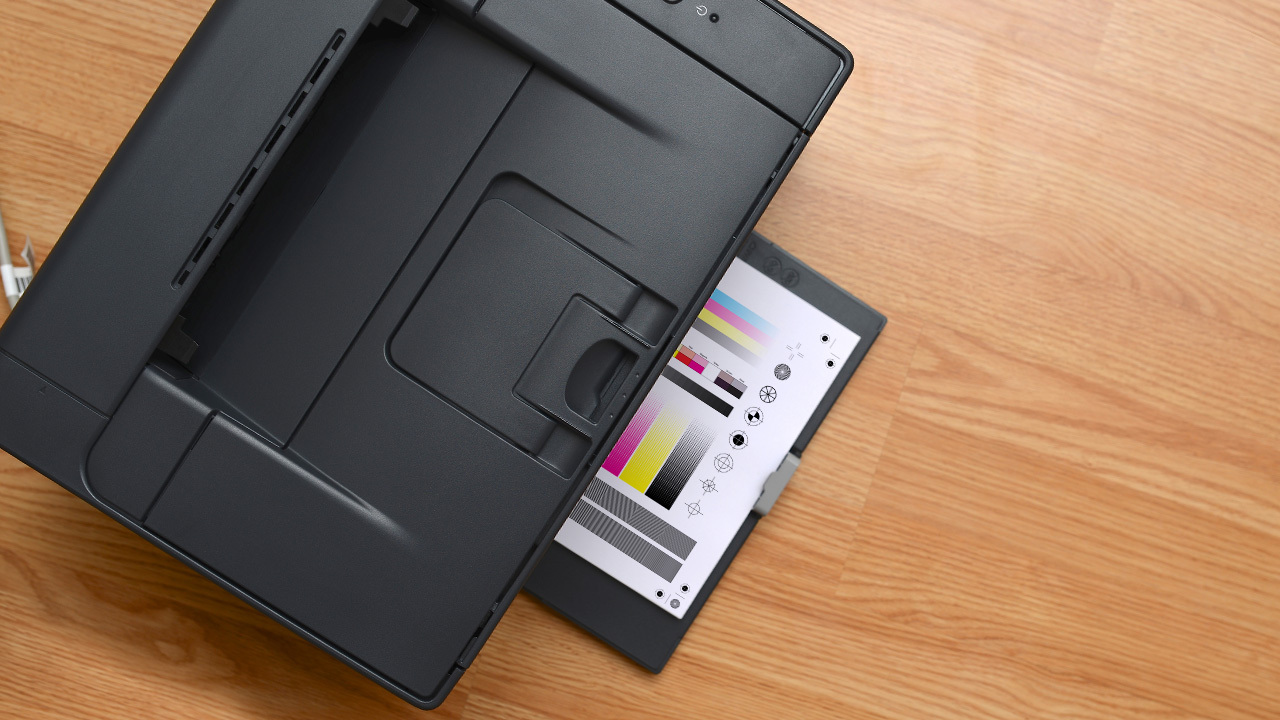Printers have come a long way over the decades. All-in-one (AIO) printers also scan, copy, fax, and send email. Some support printing from cameras, memory cards, and USB keys; others print on special media such as optical discs. Our thorough testing covers every aspect of printer functionality, print quality and speed, and hardware and software usability.

Our Suite of Tests
To thoroughly test every aspect of printing, we have assembled two sets of documents. We print each one several times to be sure we're getting the full picture of how well a printer works.
The business suite includes documents created in and printed from Adobe Acrobat and Microsoft Word, Excel, and PowerPoint. Some have only text, while others include embedded charts and photos. All output is on plain paper, and all images are printed in default mode.
The photo suite includes 300dpi resolution photographs in two sizes: 4 by 6 inches, and 8 by 10 inches. We use nine color photos and one monochrome photo. The color images are chosen to include skin tones, a wide range of shading from dark to light in a single image, and memory colors (real-world colors people tend to remember) such as grass green and sky blue. For photo printing, we use the paper the vendor recommends; if there is no vendor recommendation, we use a high-quality plain paper for lasers or a generic photo paper for inkjets. We print photos at the highest quality available without using custom or advanced settings.
To measure performance, we time and report results for the 12-page Word document in the business applications suite and for the 4-by-6 photos in the photo suite. We print each document several times and average the results.
First we report the times for the entire Word document, for the first page only (as a first page out, or FPO, time), and for the rest of the document without the first page. We also report the speed in pages per minute (ppm) for the entire document and the document without the first page included. Because this is a text document, it needs little to no processing time, which means the results reflect the fastest speeds you can expect to see from the printer. Documents with graphics, photos, or even text with significant formatting are likely to take longer. We also report the average time in seconds for printing a 4-by-6-inch image.
For testing output quality, we use both the files that we time and the additional output printed as part of our business applications and photo suites. We judge the result using carefully selected criteria and a clearly defined scale for each measure. We separately report speed and print quality for text, graphics, and photos. How well a printer does on any one type of document isn't necessarily indicative of how well it will do on the others.
For text quality, we look at the output for several fonts, in sizes ranging from 4 to 12 points, in the printer's default mode on plain paper. We pay special attention to how well-formed the characters are at each font size and how sharp the characters' edges are. We also consider how well the printer maintains the separation between characters, how well it holds the loops in characters like lowercase Es and Gs, and whether the text is a suitably dark black rather than gray.
For graphics quality, we analyze Microsoft Excel charts and Microsoft PowerPoint slides. We test for color saturation, consistency of fills, posterization (lack of smoothness in gradients), banding, misregistration, ability to hold thin lines, and dithering. We also look for any other problems that show up with any given printer.
For photo quality, we analyze the accuracy of image reproduction on photo paper. We also consider the photos included in our business applications suite, printed in the printer's default mode on plain paper.
For functionality testing, we measure ease of hardware setup, software installation, and network setup. We also look at how easy it is to use features such as front-panel menus, driver settings, PictBridge support, printing from a USB memory key, printing from websites, and interfacing with mobile devices.
Recommended by Our Editors
We note input capacity and number of paper trays for paper handling, and we test duplex (two-sided) printing for printers that offer it. Where printers have additional paper-handling capabilities such as stackers, sorters, and finishers with a stapler and hole-punch features, we test those features as well.
Additional tests for all-in-one printers (AIOs) vary by model, depending on the functions the individual printer offers. Typical roles include scanning and copying, including testing automatic document feeder speed and OCR accuracy. (For more on this, see how we test scanners.)
In general, we design our tests to confirm that each function works and is appropriate for the target user. Suppose an AIO (also known as a multifunction printer, or MFP) is limited to a flatbed for scanning, for example, and is intended for light-duty copying and document scanning in an office. In that case, we confirm that it can indeed both scan and copy and that the output quality is suitable for office use.
Finally, with both single-function and multifunction printers, we test any unique features—such as early implementations of newly introduced connection options—to make sure they work as promised and are actually useful.
Our consistent use of the same protocols for every printer allows us to make accurate and useful comparisons between models so you know exactly how they measure up. No matter what you need a printer for, we'll help you find one that's exactly right.
Get Our Best Stories!
This newsletter may contain advertising, deals, or affiliate links. Subscribing to a newsletter indicates your consent to our Terms of Use and Privacy Policy. You may unsubscribe from the newsletters at any time.
Thanks for signing up!
Your subscription has been confirmed. Keep an eye on your inbox!
Sign up for other newsletters
Read the latest from Tony Hoffman
Read the latest from M. David Stone
About William Harrel
Former Contributing Editor


















